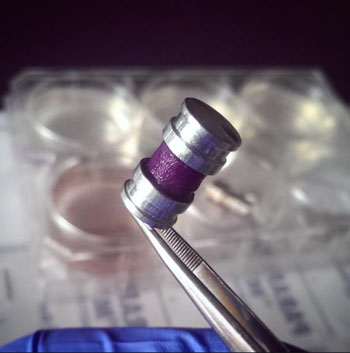Researchers Culture Novel Three-Dimensional Artificial Tumors
By LabMedica International staff writers
Posted on 07 Dec 2015
A team of Canadian cancer researchers has developed a novel method for growing three-dimensional cultures of cancer cells that behave as artificial tumors and which can be readily resolved to evaluate the response of individual cells to different levels of oxygen and nutrients.Posted on 07 Dec 2015
The cells growing in the center of a tumor have reduced access to oxygen and nutrients as compared to those growing near the surface, nearer to blood vessels. These subtle, location-dependent environment differences influence cell behavior, but their effect has proven difficult to replicate in laboratory culture.

Image: This rolled-up strip of engineered tissue allows researchers to mimic the way cells grow in a tumor, yet it can be unrolled in seconds for detailed analysis (Photo courtesy of Darren Rodenhizer, University of Toronto Engineering).
Investigators at the University of Toronto (ON, Canada) have reported the development of a novel culture system in the form of a rolled-up sheet that mimics the three-dimensional environment of a tumor, yet can also be taken apart in seconds.
The investigators impregnated a short strip of a porous, paper-like support material with collagen and cancer cells. The strip was then incubated for 24 hours in a nutrient-rich culture solution, which allowed the cells to adjust to their new environment. The strip was then rolled around a metal core, forming an artificial tumor, which was then cultured for several more days before performing analysis of tumor cell behavior. By unrolling the strip, the model could be rapidly disassembled for snapshot analysis, allowing spatial mapping of cell metabolism in concert with cell phenotype.
Results published in the November 23, 2015, online edition of the journal Nature Materials revealed that as the oxygen level decreased in internal areas of the tumor roll, the number of dead cells increased, which indicated that the cells had responded to the oxygen gradient.
Cells able to live under hypoxic conditions were found to behave differently than the surface cells: for example, they more strongly expressed genes associated with low oxygen conditions. Changes in gene expression, as determined by liquid chromatography tandem mass spectrometry metabolic signature analysis, were gradual and continuous along the length of the strip.
Senior author Dr. Alison McGuigan, professor of chemical engineering at the University of Toronto, said, "The technology holds great promise for the field of personalized medicine. The idea would be to take a patient's own cells and create copies of their tumor. These copies could then be subjected to various treatments and analyzed by the simple unrolling process, providing information about what is likely to work best for that specific patient. It is very translatable and transferable to other labs. We definitely want others to use it, because the larger the community, the more applications we will discover."
Related Links:
University of Toronto














